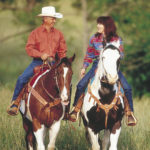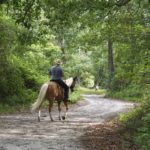There’s nothing like having what you need when you need it to help you feel competent and in control. When you and your horse are ready to leave home and go out on the trail, you can prepare for the changing environment and its challenges with additional clothing and equipment that’s simple and affordable.

To help you plan ahead, our experts?trainer and trail clinician Bruce Lachiusa and Tevis Cup-winning endurance rider Lori Stewart?tell what they take along on the trail, depending on where and when they?re going and for how long.
For You
Extra layers of clothing. Include a lightweight wind-and water-resistant pullover, for changes in weather.
Bandanna. ?A bandanna is over my ears in cold weather, around my neck in hot weather. It’s an emergency compress, or a hanky. It repairs equipment, or ties stuff to my saddle,? says Stewart.
Gloves. Use to keep your hands warm, protect your hands when handling rocks, branches, brush, and wire.
Fanny pack. Find one that fits close to your body without bouncing. Inside it, stash the items you would want to keep with you if you and your horse happen to separate, including:
– Cell phone, to call for help, or to phone home.
– Pocket knife or multipurpose tool.
– Whistle, more audible than a yell for getting help.
– Flashlight, for dealing with emergencies in the dark, finding your way, and helping others to find you.
– Large plastic trash bag (fold small and secure with a rubber band) for emergency poncho, ground cloth, or tablecloth.
– Purse-size pack of facial tissues.
– Juice box or other packaged drink.
– Durable concentrated energy food, such as a PowerBar or Clif Bar (in outdoor and health-food stores) or Payday candy bar. ?Avoid things that melt or crumble,? says Stewart.
– Sample-size bottle of sunblock.
– Lip balm with UV protection.
– Small tube of petroleum jelly or Desitin to treat minor abrasions or chafing.
– Topographical map (from a stationery or outdoor store) or good road map of the area where you plan to ride. Get your horse used to your unfolding it at home, on the ground, and then (cautiously) on horseback.
Water bottle(s). These are valuable for long rides. Trail and some tack stores have these in no-bounce holders that fasten to the saddle in front or behind you (either works, says Stewart)?or choose a cantle bag with bottle holder attached.
Cantle bag. Make sure the one you buy can attach to your saddle. Most are made for Western saddles, but you can find one that works for your English saddle, too. Look for one that includes water bottles/holders. In your cantle bag, stow:
– Easyboot to keep the small problem of a lost shoe from becoming the big problem of a damaged foot.
– Hoof pick.
– Small roll of duct tape for emergency repairs or reinforcing Easy Boot.
– Reflective vest (as little as $4 in surplus stores, suggests Lachiusa) for safety if you’re caught out after dark; rolls up.
– Roll of reflective tape for hock- and tail-wrapping after dark.
– Extra bandanna.
– Roll of bandaging tape, such as Vetrap, for emergency care.
– Extra-long leather bootlaces for repairing tack or tying objects to saddle.
– Inexpensive stethoscope for checking pulse and gut sounds. Stewart stores hers by stuffing it inside an old sock.
– Spray bottle of water/alcohol or water/witchhazel mix to cool your horse; seal in Ziploc bag to avoid leaks.
– First-aid kit including bandages, antibacterial cream, etc.
This story appears in the Tractor Supply Company’s “Trail Riding Essentials.”





